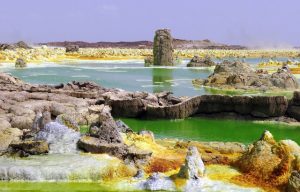Living beings, especially microorganisms, have a surprising ability to adapt to the most extreme environments on our planet, but there are still places where they cannot live. European researchers have confirmed the absence of microbial life in hot, saline, hyperacid ponds in the Dallol geothermal field in Ethiopia.
The infernal landscape of Dallol, located in the Ethiopian depression of Danakil, extends over a volcanic crater full of salt, where toxic gases emanate and water boils in the midst of intense hydrothermal activity. It is one of the most torrid environments on Earth. There, daily temperatures in winter can exceed 45° C and there are abundant hypersaline and hyperacid pools, with pH values that are even negative.
A recent study, published this year, pointed out that certain microorganisms can develop in this multi-extreme environment (simultaneously very hot, saline and acid), which has led its authors to present this place as an example of the limits that life can support, and even to propose it as a terrestrial analogue of early Mars.
However, now a French-Spanish team of scientists led by biologist Purificacion Lopez Garcia of the French National Centre for Scientific Research (CNRS) has published an article in Nature Ecology & Evolution that concludes otherwise. According to these researchers, there is no life in Dallol’s multi-extreme ponds.
Read more: archaeology news network
Ask me anything
Explore related questions





